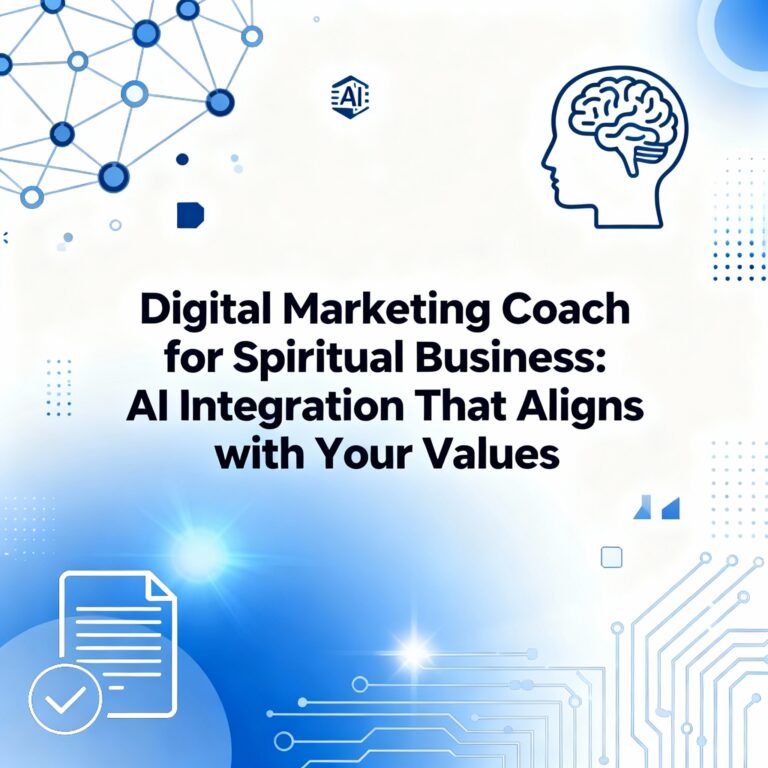Are you a coach ready to scale your business and reach more clients with ease? The coaching industry is growing fast, but the way clients find and choose coaches has changed. People search through quick summaries, short videos, and chat-style answers. To scale your coaching business, the goal is steady visibility, consistent leads, and programs that deliver outcomes clients can feel.
Clients search through summaries, short videos, and chat-style answers. To scale your coaching business, build a digital system that gets discovered, earns trust, and converts consistently. Use these seven expert tips to create steady demand and stronger revenue.
Digital marketing for coaches is more than posting on Instagram or running ads. It’s a system for discovery, trust, and conversion. By using targeted keywords, creating helpful content, optimizing for search, and building a first-party audience through email, coaches can increase visibility, generate leads, and close more clients. This blog will break it down with actionable tips on SEO content, pillar pages, lead magnets, webinars, testimonials, and conversion funnels—so the coaching business not only looks good online but grows with steady demand.
This guide on 7 digital marketing tips to scale your coaching business will help build a strong online presence, attract qualified leads, and convert interest into paid programs. Learn how to use SEO for coaches, short-form video, email marketing, content marketing, and social media strategies to position your brand as a trusted expert. With clear steps and simple tools, these strategies make growth predictable
1) Be present where AI gives answers
Search is shifting from links to answers. Google’s AI Overviews and chat-style engines often quote specific, well-structured pages especially those with clear headings, concise definitions, and credible sources. The goal is not only ranking; it’s being cited inside AI summaries. Build topic hubs around core offers (e.g., leadership coaching, wellness coaching, business coaching), then add Q&A sections, checklists, and short definitions under every subtopic. Use simple structure: What it is, how it works, steps, mistakes to avoid, and examples. Keep content fresh with updated stats and case snapshots so it stays relevant.
Clients often get answers directly on the results page or inside chat-style tools. If your content isn’t part of those answers, visibility drops. To show up, build topic hubs around your core offers—leadership coaching, wellness coaching, business coaching—and structure content so it’s easy to quote.
What helps most:
-
Keep headings natural and question-led (What, How, Why, When).
-
Start each page with a short summary of the value.
-
Include simple definitions, a few clear steps, examples, and a quick checklist.
-
Add FAQs that answer client questions in 2–3 lines.
Why this works: it respects your client’s time, and it makes your expertise easy to feature wherever they search.
2) Use short-form video to build trust fast
Short-form video is now the fastest way to earn attention and trust. Clients prefer quick, useful insights over long monologues. Platforms like Instagram Reels, YouTube Shorts, and TikTok reward clear teaching, clean hooks, and repeatable formats.
Clients want quick wins and a real sense of who they’ll be working with. Short videos do this better than long posts. Share one tip, one exercise, or one mindset shift in 30–60 seconds. Speak like you would in a real session—calm, practical, human.
How to make it simple:
-
Use a 3-second hook: the problem your client feels right now.
-
Share one actionable idea they can try today.
-
Film in the same spot, with the same format, each week.
-
Add captions and post at the times your audience is active.
Focus on value: one tip, one exercise, one reframe. Batch-record weekly, keep lighting and sound decent, and add captions. Use a simple content rhythm: 40% teaching, 30% credibility (wins, testimonials, behind-the-scenes), 20% objections and myths, 10% offers.
3) Build a first-party data engine (email + CRM)
Social reach changes. Email doesn’t. Own the relationship with email and a lightweight CRM. Offer a valuable lead magnet—toolkit, template, checklist, or a 5-day mini curriculum—and nurture with a weekly, helpful note. Segment by interest or stage of journey so the right people get the right invitations. Automate core sequences: welcome, value education, webinar invite, and re-engagement. Keep email tone simple and personal—short lessons, quick stories, and one clear call-to-action.
Own your audience with a clean, respectful newsletter and a simple CRM. Offer a useful lead magnet—a template, checklist, or a mini course—and deliver a weekly email that feels like a helpful session in their inbox.
Make it personal:
-
Segment by interest (leadership, wellness, sales, mindset).
-
Send short notes with one lesson, one story, and one next step.
-
Automate a 5-email welcome flow: your values, a quick win, a mini case, your method, an invite.
Email is where trust deepens. Keep it real, keep it consistent, and focus on service over selling.
4) Package offers for outcomes
Clients want results they can measure. Package your work around a clear promise, a timeline, and supportive systems. Add elements that help clients stick with the journey: weekly prompts, office hours, templates, and community access.
Keep it clear:
-
Signature program (6–12 weeks) with milestones and support.
-
Group coaching for scale and community momentum.
-
A self-paced track for those who want to start small.
Pricing becomes easier when the outcome is clear and the path is structured.
5) Lead with proof and practical guidance
Trust grows when people can see how you work and what changes because of it. Share mini case snapshots: starting point, what changed, and the outcome. Publish comparison guides and “when to use vs when to avoid” posts to help clients choose wisely.
Simple actions:
-
Add your bio with credentials and a few key wins.
-
Share frameworks you use in sessions—clean, step-by-step.
-
Keep language plain; avoid buzzwords. Make it easy to follow.
Clients feel safe when they know what to expect. Your clarity reduces their doubt.
6) Grow with live workshops, partnerships, and community
Run monthly workshops or mini masterclasses that solve one real problem and lead into your offer. Keep them short, practical, and interactive. Offer value-first sessions for their audience and share lead capture. Lastly, build a community space where clients and prospects connect, ask, and learn—consistency here compounds authority.
Live sessions convert because people can feel your energy and ask questions. Run a monthly workshop that solves one real problem and ends with a gentle invitation to work together.
Keep it human:
-
Choose one topic, one promise, and one offer per workshop.
-
Invite partners to co-host and share signups.
-
Maintain a small community space (WhatsApp, Telegram, Slack) for questions, wins, and prompts.
This creates steady discovery, warmer leads, and a reputation built on service.
7) Track what matters and improve one step at a time
Scaling needs simple, honest metrics. Track weekly leads, booked calls, show rate, close rate, and program completion. For traffic, watch search impressions, email opt-ins, and video retention. Scaling feels calmer when you measure simply and adjust slowly. Look at weekly leads, booked calls, show rate, close rate, and client completion. For content, track search impressions, email opt-ins, and video retention.
A grounded approach:
-
Use a one-page dashboard.
-
Keep experiments small and focused.
-
Double down on topics and formats that bring real conversations and bookings.
Progress compounds when you improve the right 10% again and again.
Personalize your funnel for coaching buyers
Not every prospect needs the same path. Meet people where they are and give them a clear next step.
-
For beginners: simple explainers, short videos, and checklists.
-
For evaluators: case snapshots, frameworks, comparisons, and pricing ranges.
-
For ready buyers: live workshops, diagnostic calls, and a clear program page with outcomes, milestones, and FAQs.
This reduces friction and respects their stage in the journey.
Keep your brand warm and human
A coaching brand grows through presence, not pressure. Choose a few rhythms and keep them steady:
-
One pillar article or guide every two weeks.
-
Four to six short videos per week.
-
One email newsletter weekly.
-
One workshop every month.
-
One partnership outreach each week.
Say less, mean more. Show up with care. Make every touchpoint useful—even when someone doesn’t buy today.
Final word
Scaling as a coach is about clarity, proof, and presence where decisions happen inside short videos, answer-style results, and trusted inboxes. Build topic hubs that AI can cite, teach freely in public, gather leads with valuable resources, and sell outcomes with support. Keep the system simple, repeatable, and human. Scaling a coaching business is about clarity, empathy, and steady systems. Be present where clients get answers. Share short, practical content that builds trust. Own your audience with email. Package outcomes that feel real. Lead with proof. Create live moments and meaningful partnerships. Track what matters and fix one step at a time.
Ready to scale your coaching business with clarity and heart?
If you’re a healer, yoga teacher, coach, or holistic entrepreneur, you deserve marketing that feels true to your work and actually brings in the right clients. Get a growth plan that blends SEO, content, email, and paid ads—built to amplify your message without losing your authenticity.
Here’s the promise: clear strategy, honest execution, and steady results. Reach people who genuinely resonate with your mission, build trust through meaningful content, and turn interest into long-term clients.
Ready to begin? Contact now to explore a custom digital marketing plan for your spiritual or coaching business and start serving more, inspiring more, and thriving with integrity.




